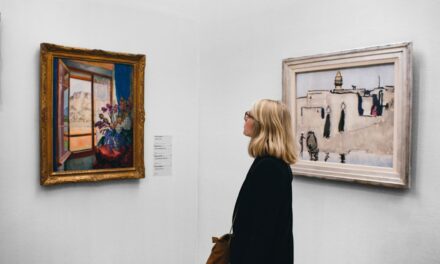Selecting the appropriate frame for your pastel artwork is a crucial step in the presentation process. Pastels, with their vibrant colours and soft textures, require a frame that not only complements the artwork but also protects it from potential damage. When considering a frame, one must take into account the style of the artwork itself.
A contemporary piece may benefit from a sleek, minimalist frame that allows the colours to take centre stage, while a more traditional pastel might be better suited to an ornate, vintage frame that enhances its classic appeal. The choice of colour and material is equally important; wooden frames can add warmth and depth, while metal frames can provide a modern edge. Moreover, the size of the frame should be carefully considered.
A frame that is too large can overwhelm a delicate pastel piece, while one that is too small may not provide adequate support or visual balance. It is advisable to leave a small margin around the artwork, allowing for a matting option that can further enhance the overall presentation. The right frame not only serves as a protective barrier but also acts as a visual extension of the artwork itself, guiding the viewer’s eye and enhancing their experience of the piece.
Summary
- When choosing a frame for pastel artwork, opt for a simple and elegant design to complement the soft and delicate nature of the medium.
- Use mounting and matting techniques to enhance the presentation of pastel artwork, such as floating the artwork to create a sense of depth and using acid-free mats to protect the artwork from discolouration.
- Protect pastel artwork from environmental factors by framing it with UV-protective glass or acrylic to prevent fading and using spacers to allow for air circulation and prevent smudging.
- Get creative with display options for pastel artwork, such as using shadow box frames to create a three-dimensional effect or arranging multiple pieces in a gallery wall layout.
- Consider custom framing options for pastel artwork to ensure a perfect fit and professional finish, including choosing the right frame moulding and mat colours to enhance the artwork.
- Follow DIY framing tips for pastel art, such as using archival materials, proper mounting techniques, and securing the artwork in the frame to ensure long-term preservation.
- Showcasing pastel artwork in gallery settings can be enhanced by using professional framing techniques, proper lighting, and strategic placement to draw attention to the artwork.
- When framing pastel artwork for long-term preservation, consider using museum-quality materials, such as acid-free mats, UV-protective glazing, and proper sealing to protect the artwork from damage.
Mounting and Matting Techniques to Enhance Your Pastel Art
Mounting and matting are essential techniques that can significantly enhance the presentation of pastel artworks. Proper mounting ensures that the artwork remains flat and secure, preventing any warping or bending over time. One effective method is to use acid-free mounting boards, which help to preserve the integrity of the pastel while providing a sturdy base.
It is crucial to avoid using adhesives directly on the pastel surface, as this can lead to smudging or damage. Instead, consider using hinging techniques with archival tape or corners that allow for easy removal if necessary. Matting serves both aesthetic and practical purposes.
A well-chosen mat can create a visual buffer between the artwork and the frame, drawing attention to the piece while also protecting it from direct contact with the glass. When selecting a mat, opt for acid-free materials to prevent discolouration over time. The colour of the mat should complement the hues within the pastel artwork; for instance, a neutral tone can provide a subtle backdrop that allows vibrant colours to pop, while a contrasting colour can create a striking visual impact.
The width of the mat is also important; wider mats can lend an air of sophistication and elegance, while narrower mats may suit more modern or minimalist styles.
Protecting Pastel Artwork from Environmental Factors
Pastel artworks are particularly susceptible to environmental factors such as humidity, temperature fluctuations, and light exposure. To ensure their longevity, it is essential to take proactive measures in protecting these delicate pieces. One of the most effective ways to safeguard pastel art is by displaying it in a controlled environment.
Additionally, using UV-filtering glass or acrylic in framing can provide an extra layer of protection against harmful light exposure. This type of glazing not only helps to preserve the vibrancy of pastel colours but also reduces glare, allowing for better visibility of the artwork from various angles.
Furthermore, consider using protective sprays specifically designed for pastels; these can create a barrier against dust and smudging without altering the appearance of the artwork. However, it is vital to test any spray on a small area first to ensure compatibility with your specific pastels.
Creative Display Options for Pastel Art
When it comes to displaying pastel artwork, creativity knows no bounds. While traditional framing is always an option, there are numerous innovative ways to showcase these vibrant pieces that can add character to any space. One popular trend is to create a gallery wall featuring an eclectic mix of pastel artworks alongside other mediums such as photography or mixed media.
This approach not only highlights the unique qualities of pastels but also creates a dynamic visual narrative that engages viewers.
This flexibility enables artists and collectors to change their displays frequently, keeping the environment fresh and exciting.
Additionally, consider incorporating easels or stands for tabletop displays; this method can be particularly effective for smaller pieces or studies, allowing them to be appreciated from various angles without being confined to a wall space. Ultimately, the key is to think outside the box and find display methods that resonate with your personal style while showcasing the beauty of pastel art.
Custom Framing Options for Pastel Artwork
Custom framing offers an unparalleled opportunity to tailor the presentation of pastel artworks to individual tastes and preferences. By working with a professional framer, artists and collectors can explore a myriad of options that cater specifically to their needs. Custom frames allow for precise measurements that ensure a perfect fit for each piece, eliminating any concerns about standard sizes that may not do justice to the artwork’s dimensions.
In addition to size considerations, custom framing provides access to an extensive range of materials and finishes. From ornate mouldings to sleek modern designs, the choices are virtually limitless. This level of personalisation enables individuals to select frames that not only protect their artworks but also enhance their aesthetic appeal.
Furthermore, custom matting options can be explored, allowing for unique colour combinations and textures that complement the pastel’s palette beautifully. Investing in custom framing is not merely about aesthetics; it is also about ensuring that your artwork is preserved in an optimal manner for years to come.
DIY Framing Tips for Pastel Art
Gathering Essential Materials
For those who prefer a hands-on approach, DIY framing can be an enjoyable and rewarding experience when it comes to pastel artworks. The first step in this process is gathering all necessary materials: acid-free mounting boards, archival tape, a suitable frame, and UV-filtering glass or acrylic if desired.
Mounting Your Pastel Piece
When mounting your pastel piece, ensure that you handle it with care; wearing cotton gloves can prevent oils from your fingers from transferring onto the surface. Use archival tape to secure the corners of your artwork onto the mounting board without applying adhesive directly onto the pastel itself. Once mounted, carefully place your piece into the frame and secure it in place with clips or fasteners designed for framing purposes.
Final Touches
Finally, if you have chosen glass or acrylic glazing, ensure it is clean and free from fingerprints before sealing your frame completely. This DIY approach not only allows for personal expression but also provides an opportunity to learn valuable skills in art preservation.
Showcasing Pastel Artwork in Gallery Settings
When exhibiting pastel artworks in gallery settings, careful consideration must be given to both presentation and lighting. Galleries often have specific requirements regarding how artworks are displayed; therefore, understanding these guidelines is essential for artists looking to showcase their work effectively. One key aspect is ensuring that each piece is framed appropriately and securely mounted to prevent any risk of damage during transport or installation.
Lighting plays a pivotal role in how pastel artworks are perceived by viewers. Soft, diffused lighting can enhance the delicate qualities of pastels without causing harsh glare or shadows that detract from their beauty. It is advisable to avoid direct overhead lighting; instead, consider using adjustable spotlights that can be angled to highlight specific pieces without overwhelming them with brightness.
Additionally, providing ample space between artworks allows viewers to appreciate each piece individually without feeling crowded or rushed.
Framing Pastel Artwork for Long-Term Preservation
The long-term preservation of pastel artworks hinges on thoughtful framing choices and techniques that prioritise protection without compromising aesthetic appeal. As previously mentioned, using acid-free materials is paramount; this includes not only mounting boards but also mats and backing materials that will not degrade over time or leach harmful chemicals into the artwork. Furthermore, selecting appropriate glazing options is crucial for safeguarding pastels against environmental factors such as dust and UV light exposure.
UV-filtering glass or acrylic should be considered essential components in any framing project aimed at long-term preservation. Additionally, ensuring that frames are sealed properly will help prevent dust accumulation while maintaining an optimal environment for the artwork itself. By taking these steps, artists and collectors can ensure that their pastel creations remain vibrant and intact for generations to come.
In conclusion, framing pastel artwork involves much more than simply placing it behind glass; it requires careful consideration of materials, techniques, and display options that enhance both protection and aesthetic appeal. Whether opting for custom framing or embarking on a DIY project, understanding these elements will empower artists and collectors alike to present their pastel creations in ways that honour their beauty while ensuring their longevity.
If you are interested in exploring more about the whimsical wonders of art, you should definitely check out the article


